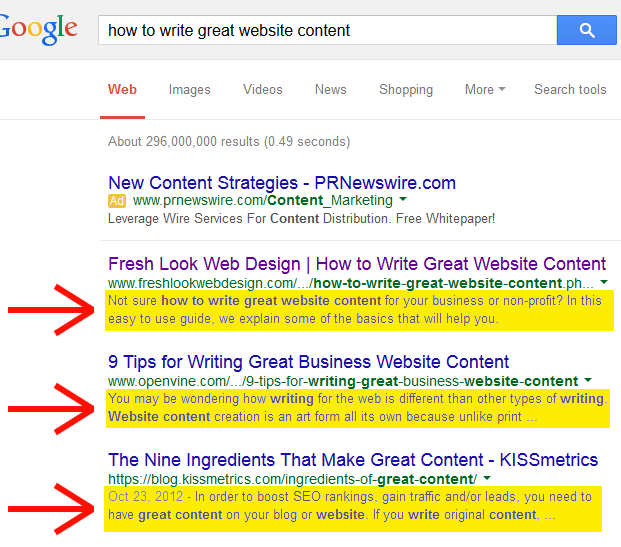If you don’t know what a meta description is, here is a basic non-technical definition:
The meta description tag is a brief, one or two sentence introduction to each individual webpage on a website. Web users won’t see it when looking at the website, but it appears on the search engine results page.
Example – I went to Google and searched “how to write great website content” (a search phrase that one of my articles happens to be ranked #1 for):
Click to zoom
As you can see, the highlighted part is the meta description. It’s what users see under each link in the search engine results page.
How many meta description tags should I have?
You should have one unique meta description tag for every page on your website. Because each page is different, Google expects to see different meta descriptions for each page.
You can use the same verbiage for all your pages, however to keep Google and your users happy, we recommend tailoring each tag for each different page so that they’re unique to that page.
What should I put in my meta description tag?
A good meta description sounds like a sales pitch. Not corny or over the top, but it entices the reader to click on the link. It needs to be very readable, short, and to the point.
You also want your meta description to stand out from the rest. Put a good call to action statement, or say something to make your users curious. Use punctuation or even limited ALL CAPS to draw the users eye.
How long should it be?
It should be around 155 characters long. Any more than that and Google may cut it off. If you want to get technical, Google actually measures how long your description is in pixels not characters. But you’re going to want to keep it fairly short anyway, so 155 characters is a good number to shoot for.
Here’s a good tool to check to see if your meta description is the right length – www.seomofo.com/snippet-optimizer.html
Does the meta description actually help my Google rank?
Not directly. Google has said that the meta description is not factored into their algorithms. However, if users are clicking on your page because you have a great meta description, then Google will take notice of that. So it does help, just indirectly.
How do I actually add meta tags to my website?
Your web developer can easily help you with this, but if you’re editing your own website with Joomla or WordPress or something similar, there are a lot of great plugins that you can download to your site. Here are a couple:
Joomla:
WordPress:
What about keywords?
It’s good to put a couple keywords in the meta description if possible. Let’s look at our example again:
Click to zoom
I typed “how to write great website content” into Google and this is what showed up. Notice how the actual words that I typed into Google is bolded in the highlighted meta description. That helps it stand out a little more. This is why I suggest that if you can, include a couple keywords in your meta description.
Don’t stuff your meta description with too many keywords. Writing for users should be your main focus. But a couple keywords in the meta description may encourage users that your page is relevant to what they are looking for.
Google isn’t using my meta description
Get this – Google may or may not choose to use your meta description. They may pick out verbiage from the main page content that they think is more relevant to the users search. Unfortunately there’s nothing you can do about it, other than make sure you follow our guidelines to writing a good meta description.
Being on the first page of Google is a great accomplishment. But writing a solid, readable, well crafted meta description will actually encourage users to click on your link. Take the time to create a good meta description and watch your website traffic increase.


